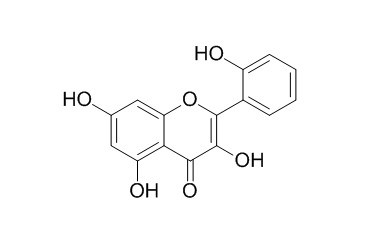2',3,5,7-Tetrahydroxyflavone
2',3,5,7-Tetrahydroxyflavone inhibits MMP-13 expression in IL-1β-treated chondrocytes, at least in part, by suppressing the c-Fos/AP-1 and JAK2/STAT1/2 pathways.
Inquire / Order:
manager@chemfaces.com
Technical Inquiries:
service@chemfaces.com
Tel:
+86-27-84237783
Fax:
+86-27-84254680
Address:
1 Building, No. 83, CheCheng Rd., Wuhan Economic and Technological Development Zone, Wuhan, Hubei 430056, PRC
Providing storage is as stated on the product vial and the vial is kept tightly sealed, the product can be stored for up to
24 months(2-8C).
Wherever possible, you should prepare and use solutions on the same day. However, if you need to make up stock solutions in advance, we recommend that you store the solution as aliquots in tightly sealed vials at -20C. Generally, these will be useable for up to two weeks. Before use, and prior to opening the vial we recommend that you allow your product to equilibrate to room temperature for at least 1 hour.
Need more advice on solubility, usage and handling? Please email to: service@chemfaces.com
The packaging of the product may have turned upside down during transportation, resulting in the natural compounds adhering to the neck or cap of the vial. take the vial out of its packaging and gently shake to let the compounds fall to the bottom of the vial. for liquid products, centrifuge at 200-500 RPM to gather the liquid at the bottom of the vial. try to avoid loss or contamination during handling.
Plant Cell,Tissue & Organ Culture2016, 127(1):115-121
Int J Mol Sci.2019, 20(9):E2244
Anal Bioanal Chem. 2016, 408(15)
Anal Bioanal Chem.2016, 408(1):177-90.
J of the Korean Society of Food Science and Nutrition2019, 32(2):148-154
Int J Mol Sci.2022, 23(1):538.
Nutr Cancer.2023, 75(1):376-387.
Phytomedicine.2018, 41:62-66
Sci Rep.2024, 14(1):3684.
Biomedicines.2022, 10(3):583.
Related and Featured Products
Journal of Pharmacological Sciences, 21 May 2011, 116(2):221-231.
Effects of flavonoids on matrix metalloproteinase-13 expression of interleukin-1β-treated articular chondrocytes and their cellular mechanisms: inhibition of c-Fos/AP-1 and JAK/STAT signaling pathways.[Reference:
WebLink]
To identify the therapeutic potential for cartilage degradation and its action mechanisms, the effects of naturally-occurring flavonoids on matrix metalloproteinase-13 (MMP-13) induction were examined in the human chondrocyte cell line SW1353.
METHODS AND RESULTS:
Flavones including apigenin and wogonin strongly inhibited MMP-13 induction in interleukin (IL)-1β-treated SW1353 cells, while flavonols such as kaempferol, quercetin, and flavanone (naringenin) did not at 5 - 25 µM. Apigenin and wogonin primarily inhibit MMP-13 by blocking the c-Fos / activator protein-1 (AP-1) and Janus kinase 2 (JAK2) / signal transducer and activator of transcription 1/2 (STAT1/2) pathways, but not nuclear factor-κB (NF-κB) signaling. Apigenin was also shown to inhibit extracellular matrix degradation in rabbit cartilage culture. The following study using some synthetic flavones demonstrated that A-ring C-5,7-dihydroxyl and B-ring dihydroxyl substitution at C-2,3, C-2,4, or C-3,4 are important for the suppression of MMP-13 expression. Among these flavones,
2',3,5,7-Tetrahydroxyflavone also inhibited both the c-Fos/AP-1 and STAT1/2 pathways.
CONCLUSIONS:
Taken together, these results indicate that certain flavonoids, especially flavones, inhibit MMP-13 expression in IL-1β-treated chondrocytes, at least in part, by suppressing the c-Fos/AP-1 and JAK2/STAT1/2 pathways. Furthermore, these findings suggest that some flavonoids have the potential for protecting against collagen matrix breakdown in the cartilage of diseased tissues such as those found in arthritic disorders.



